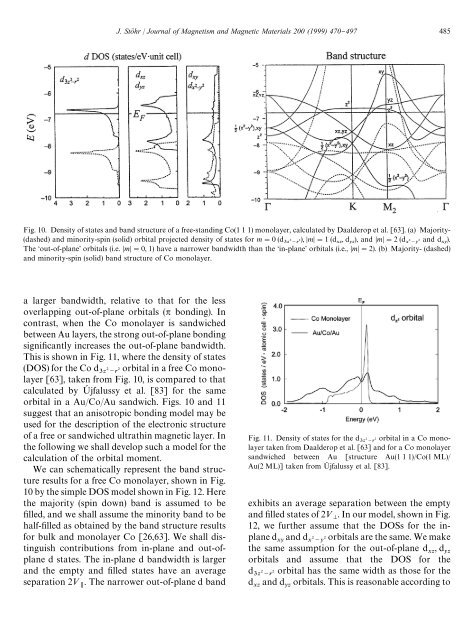Exploring the microscopic origin of magnetic anisotropies with X-ray ...
Exploring the microscopic origin of magnetic anisotropies with X-ray ...
Exploring the microscopic origin of magnetic anisotropies with X-ray ...
Create successful ePaper yourself
Turn your PDF publications into a flip-book with our unique Google optimized e-Paper software.
J. Sto( hr / Journal <strong>of</strong> Magnetism and Magnetic Materials 200 (1999) 470}497 485<br />
Fig. 10. Density <strong>of</strong> states and band structure <strong>of</strong> a free-standing Co(1 1 1) monolayer, calculated by Daalderop et al. [63]. (a) Majority-<br />
(dashed) and minority-spin (solid) orbital projected density <strong>of</strong> states for m"0(d ), m"1(d ,d ), and m"2(d and d ).<br />
The &out-<strong>of</strong>-plane' orbitals (i.e. m"0, 1) have a narrower bandwidth than <strong>the</strong> &in-plane' orbitals (i.e., m"2). (b) Majority- (dashed)<br />
and minority-spin (solid) band structure <strong>of</strong> Co monolayer.<br />
a larger bandwidth, relative to that for <strong>the</strong> less<br />
overlapping out-<strong>of</strong>-plane orbitals ( bonding). In<br />
contrast, when <strong>the</strong> Co monolayer is sandwiched<br />
between Au layers, <strong>the</strong> strong out-<strong>of</strong>-plane bonding<br />
signi"cantly increases <strong>the</strong> out-<strong>of</strong>-plane bandwidth.<br />
This is shown in Fig. 11, where <strong>the</strong> density <strong>of</strong> states<br />
(DOS) for <strong>the</strong> Co d orbital in a free Co monolayer<br />
[63], taken from Fig. 10, is compared to that<br />
calculated by UD jfalussy et al. [83] for <strong>the</strong> same<br />
orbital in a Au/Co/Au sandwich. Figs. 10 and 11<br />
suggest that an anisotropic bonding model may be<br />
used for <strong>the</strong> description <strong>of</strong> <strong>the</strong> electronic structure<br />
<strong>of</strong> a free or sandwiched ultrathin <strong>magnetic</strong> layer. In<br />
<strong>the</strong> following we shall develop such a model for <strong>the</strong><br />
calculation <strong>of</strong> <strong>the</strong> orbital moment.<br />
We can schematically represent <strong>the</strong> band structure<br />
results for a free Co monolayer, shown in Fig.<br />
10 by <strong>the</strong> simple DOS model shown in Fig. 12. Here<br />
<strong>the</strong> majority (spin down) band is assumed to be<br />
"lled, and we shall assume <strong>the</strong> minority band to be<br />
half-"lled as obtained by <strong>the</strong> band structure results<br />
for bulk and monolayer Co [26,63]. We shall distinguish<br />
contributions from in-plane and out-<strong>of</strong>plane<br />
d states. The in-plane d bandwidth is larger<br />
and <strong>the</strong> empty and "lled states have an average<br />
separation 2< , . The narrower out-<strong>of</strong>-plane d band<br />
Fig. 11. Density <strong>of</strong> states for <strong>the</strong> d orbital in a Co monolayer<br />
taken from Daalderop et al. [63] and for a Co monolayer<br />
sandwiched between Au [structure Au(1 1 1)/Co(1 ML)/<br />
Au(2 ML)] taken from UD jfalussy et al. [83].<br />
exhibits an average separation between <strong>the</strong> empty<br />
and "lled states <strong>of</strong> 2< . In our model, shown in Fig.<br />
12, we fur<strong>the</strong>r assume that <strong>the</strong> DOSs for <strong>the</strong> inplane<br />
d and d orbitals are <strong>the</strong> same. We make<br />
<strong>the</strong> same assumption for <strong>the</strong> out-<strong>of</strong>-plane d ,d <br />
orbitals and assume that <strong>the</strong> DOS for <strong>the</strong><br />
d orbital has <strong>the</strong> same width as those for <strong>the</strong><br />
d and d orbitals. This is reasonable according to











